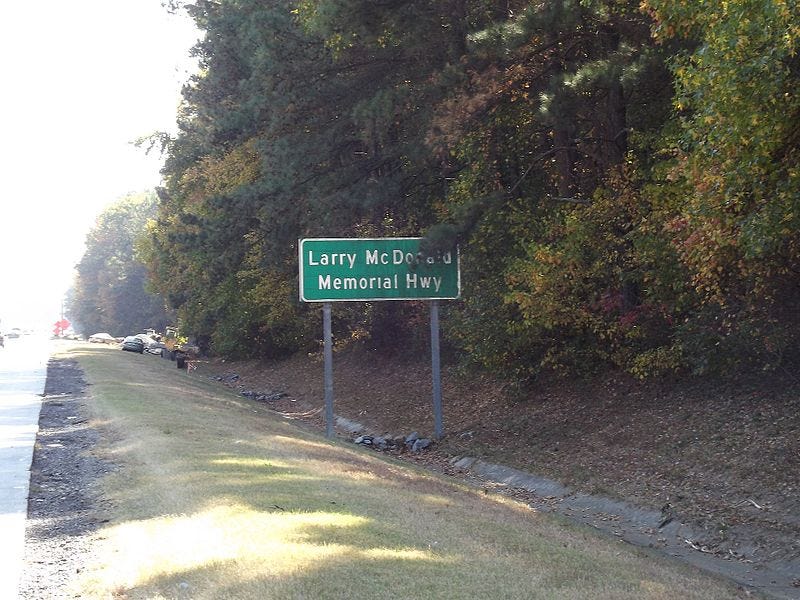Larry McDonald
NW Georgia - where movement and social conservatives have a long, strange history
By Tom McMahan. This is the third in a multi-part series of articles on Trumpism in North Georgia, the U.S., and even across the world. The first two parts are linked here and here.
When I decided to take on this little project of writing about a social movement as amorphous (as all social movements are) and contemporary as Trumpism is, I knew it was going to be a struggle to carefully spell out its many different parts and pieces. Describing the two largest groups of people who make up that movement, as hard as that is, is the easiest part of this, and so that’s why I’ve focused on them first. Last time in “Sand Mountain,” I described what I refer to as “Old Democrats,” a more politically-driven term I’m using to describe that part of Trumpism that is filled with people I actually refer to as conservative Christians most of the time. It is their faith, a particular kind of Christian faith that will be the subject of the next article, that gives them their most defining characteristics.
That faith also assisted in galvanizing and organizing the second major group within Trumpism…just not quite as much. From the beginning, this group, which I’m going to use the more neutral term “Movement Conservatives” for…but who I like to refer to as christian Conservatives (note the location of capitalization in both bolded terms). It is their ideology that has given this group their most defining characteristic.
I’ve been thinking about these distinctions for years, but I was struggling to find a local “hook” for how to introduce this group in this series when it literally flashed by my face as I was driving through Catoosa County.
Well d’uh! LOL I had driven by those signs so many times over the years, I had just tuned them out. But Larry McDonald is as perfect…and “local”…of an example of a “movement conservative” as anyone can find in these parts!
I think many of you reading this already know who Larry McDonald was, and probably remember his utterly bizarre and horrifying “Twilight Zone” like death at the hands of the Soviet Union of all things (open the “death flight” PDF file at the bottom of that linked page and read it, it’s worth a few minutes of your time), which is what landed the name of an otherwise do-nothing and ideological extreme Congressman on signs along I-75.
Larry McDonald is noteworthy in this series for a couple of reasons:
McDonald was elected to the House as part of the “Watergate” Class of ‘74. McDonald was a Democrat like everyone else in that group, but he stood apart from the rest like a sore thumb otherwise.
Instead of being liberal (the ‘74 Class in many ways was the “arrival” of the more liberal Democratic Party of today legislatively, following the Kennedy/Johnson years because legislatures always lag due to the power of seniority and gerrymandering), McDonald, representing Georgia’s 7th Congressional District in NW Georgia, was an arch-conservative, a member (and when he died Chairman) of the John Birch Society. He was fiercely anti-communist, fiercely anti-New Deal (and Great Society), was publicly accused of being fascist and a white nationalist (he was both), and was conspiratorial on matters great and small — he horded gold and silver because fiat money was communistic; he thought fruit pits could cure cancer, which ran him and his urology practice afoul of malpractice suits and the FDA; he hoarded and most likely smuggled weapons; he formed his own intelligence gathering agency with the help of far-right neo-Nazi money from Germany; he did not concern himself at all with day-to-day congressional matters.
While McDonald was a Democrat representing NW Georgia, his upset election (he defeated John Davis, who was part of the Chattooga County/Bobby Lee Cook political machine there for years) in the Democratic Primary was the leading edge of the partisan conversion of our area. That conversion ended when Nathan Deal switched to the Republican Party in 2003, and can be confusing to people alive today who see “conservative” and “Republican” as interchangeable terms. By 1974, the national Democratic Party had become the “liberal” pro-civil rights party, but two things had to happen for Georgia conservatives like McDonald or Deal to move to the Republican Party. One was having Newt Gingrich, another movement conservative from Cobb County, lead a Republican majority in the US House in 1994. The second was Sonny Perdue, the state Republican majority in the Assembly, and their defense of the Confederate flag they all rode into power on (and quickly disposed of) in 2002. That ensured these conservatives a stable base of operations for their Congressional careers. But let’s not forget that it was Georgia Democrats whose gerrymandering politically wedded metro Atlanta with rural north Georgia originally for their own political benefit. Both parties can be very creative at this when they start getting desperate to hang on to majorities.
In between the 1970s and 2000s was the massive “white flight” phenomenon out of Atlanta and into the suburbs of the north, especially Cobb County, over issues like racial integration and busing. Once this “conservative movement” (literally) established a power base in the rapidly growing ‘burbs, representatives like McDonald and especially Gingrich wed that movement with more religious and social issues like abortion and gun control to build a large enough political consensus with the “Old Democrats” to create the modern Republican Party we now know.
McDonald…and Newt Gingrich…and Nathan Deal…and Brian Kemp…and Marjorie Taylor Greene…all of them came from the north Atlanta suburbs and have sought out the Old Democrats and their descendants in the hills of North Georgia in their search for political power. Those last two, Kemp and Greene, now find themselves at the lagging end of this phenomenon. Now those same suburbs have become racially diverse and far more moderate…and increasingly Democratic. A pragmatic conservative like Kemp sees this and seeks a way to hang onto the suburbs just a bit longer for his own ambition (a Senate run in 2026) by pushing away from Trumpism (but only just a little bit.) A true-believing fanatic like Greene flees the suburbs entirely and retreats into the hills where she still has a large enough (but gradually shrinking) base to sustain her one-woman self-aggrandizement show. (Greene was the least popular Republican in the 14th CD in the 2022 election.)
Next week, a look at the “secret sauce” that has powered and united these two different groups, white conservative evangelical Christianity.






